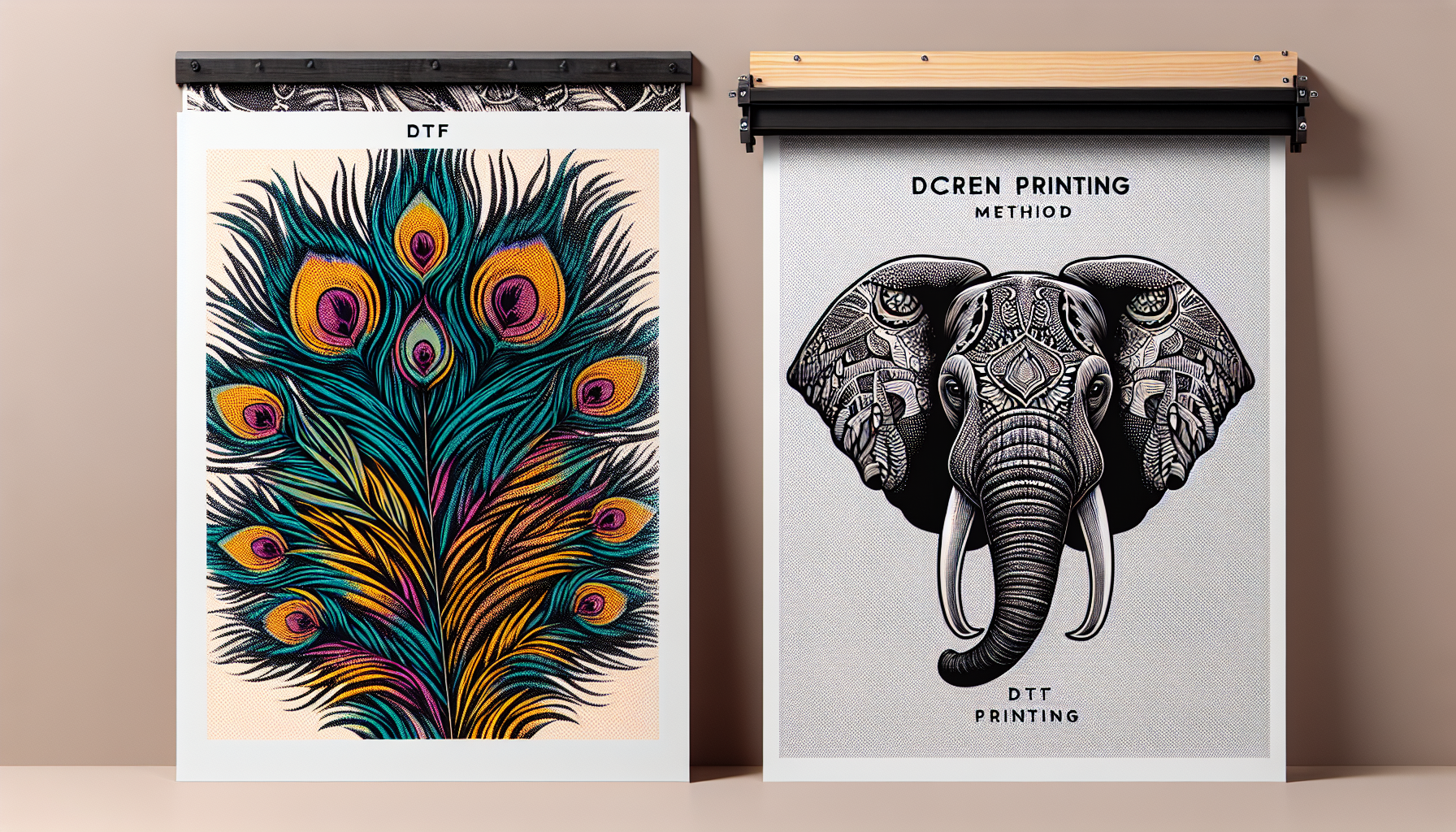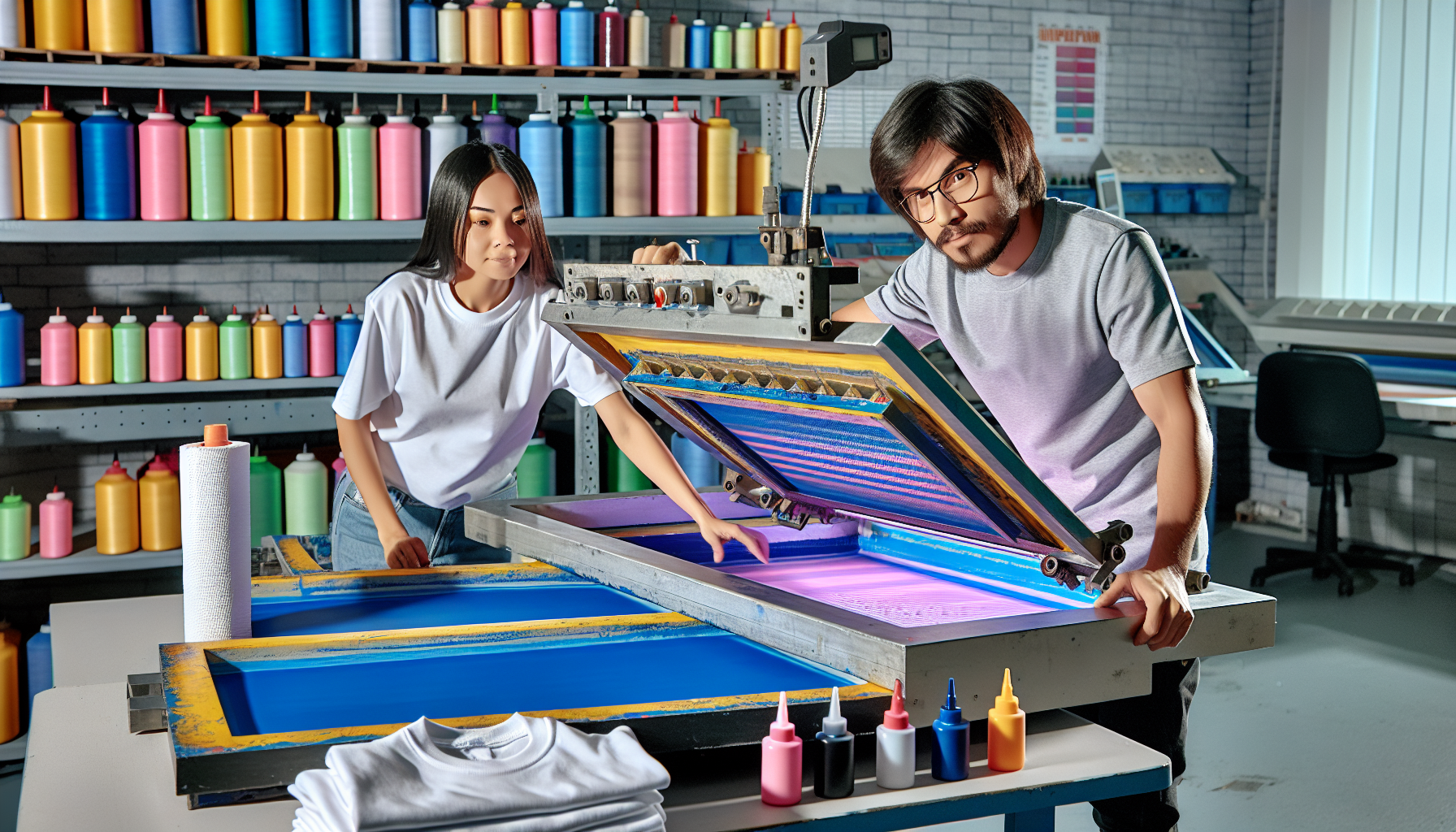
Do you have to choose between two popular print methods, DTF and screen printing, for your fabric creations? This guide provides a comprehensive comparison of the two techniques in terms of print quality, versatility, and pricing strategies. We aim to help you make an informed decision by highlighting the key differences that set DTF and screen printing apart based on your specific print requirements.
Key Takeaways
- DTF (direct-to-film) printing excels in print quality and detail with the ability to produce high-definition, photorealistic prints on a wide range of materials, but involves higher costs and specialized equipment which may present challenges in durability and color gradient reproduction.
- Screen printing is renowned for its durability and vibrancy in simple, bold colors, making it cost-effective for large print runs, but struggles with complex, multi-colored designs and can have a more significant environmental impact due to waste generation and emission of harmful gases.
- Choosing between DTF and Screen Printing depends on factors such as design complexity, order size, production timeline, environmental concerns, and specific use cases, with DTF being more versatile and suitable for smaller orders and detailed designs, and screen printing favored for bulk orders and simpler graphics.
Understanding DTF and Screen Printing

Choosing between DTF and screen printing for apparel can be difficult as both methods have their advantages and disadvantages. Understanding the fundamentals of each technique is crucial in making an informed decision since they are two widely used options when it comes to clothing printing. Both techniques should be considered carefully before deciding which one best fits your needs.
DTF Printing Essentials
Direct-to-film (DTF) printing is a digital process that uses water-based ink and specialized equipment, including a DTF printer, CMYKW inks, software, and film with hot melt powder. The crucial role of the heat press machine in transferring the printed-out design directly from PET film onto fabric or any other desired surface cannot be overlooked.
Thanks to the use of high-quality films and specifically designed inks for this technique, DFT Printing produces vibrant and top-notch prints. The base color white enhances the vividness of colors resulting in crisp details on the final output.
Screen Printing Fundamentals
Screen printing, a traditional method of printing, utilizes a stencil made on a fine mesh screen to apply ink and achieve the product quality desired design. To carry out this process effectively, one needs tools such as scoop coaters, screen tape, and an ink spatula or scoop.
One advantage of using screen printing is its ability to produce long-lasting designs with vibrant colors by incorporating a white under base when working with dark garments. It may face difficulties in handling intricate designs due to potential issues that can arise from engraving halftone raster or micro-patterns onto the screen. Despite these challenges, many still opt for this form of printing because of its unique ability to create multi-color designs for eye-catching results.
Comparing DTF and Screen Printing Techniques

After going over the fundamentals of both screen printing and DTF, let’s compare them directly in terms of DTF vs. full-screen print transfers. We will examine their print quality, flexibility, and cost implications to assist you in making a well-informed decision for your specific printing requirements.
Print Quality and Detail

DTF printing has been proven to produce superior print quality and intricate details compared to traditional screen printing alone. This technique is renowned for its ability to create high-definition, realistic prints with vibrant colors, excellent color reproduction, sharp image clarity, and fine details. It also results in a softer hand feel and smoother surface on the printed material.
Screen printing traditionally relies on incorporating a white under base when dealing with dark garments to achieve bold colors. However, this often requires using separate screens for each color, which can be tedious and labor-intensive. Moreover, screens may encounter difficulties when reproducing complex designs due to potential unwanted effects that arise from engraving halftone raster or micro-patterns onto them.
When it comes down to comparing both methods of printing, it’s clear that DTF holds an edge over screenprints in terms of producing visually appealing outcomes. Whether it’s through generating vivid hues, effectively replicating true-to-life images, and accentuating every detail needed, in combination with achieving impressive softness on surfaces of any kind. Due to undesirable consequences stemming from attempting to imprint micro/complex designs by adding a degree of tactility, its overall effectiveness shows itself as easily surpassing countless shortcomings associated with screen printers. Thus, making way for a quicker and cost-effective alternative over the traditional printing method, which is way more time-consuming.
Versatility and Material Compatibility
When it comes to adaptability and compatibility with different materials, DTF printing proves to be the top choice. This method can easily print on a wide range of fabrics including cotton, and nylon, as well as both light and dark-colored ones, which makes it highly favored in the field of printing. On the other hand, while screen printing is commonly used for various materials and types of fabric surfaces, its best outcomes are achieved when working with cotton or specific blends.
Although screen printing has versatile application potential towards an array of materials such as fabric varieties. Some delicate options like silk, lace, and chiffon may not react positively due to their sensitivity to this process methodology. So careful consideration must be given before utilizing screen-printing techniques on these fragile textiles.
Cost Implications and Order Sizes
The cost-efficiency of DTF printing for smaller quantities is due to its minimal setup costs. Since no separate screens are needed for each color, it avoids the expensive and laborious process involved in a separate screen for printing. On average, prices for DTF printing on small orders range from $1.30 to $15 per item, depending on factors like ink consumption, film expenses, and order size.
In contrast, screen printing becomes more economical when dealing with larger quantities, but does require higher initial setup investments. The cost usually decreases as production scales up due to efficiencies in the process and reduced setup fees.
Shops often offer better rates for minimum quantity orders starting at around 12 shirts because of this reason.
Advantages and Disadvantages of Each Method
Although both DTF and screen printing offer their own set of benefits and drawbacks, having a thorough understanding of these can assist in making the best decision for your specific print job.
Let us now explore the pros and cons associated with each technique.
Benefits of DTF Printing
The utilization of DTF printing technology offers various advantages for businesses, such as the ability to produce high-quality prints, with vivid and dynamic colors. The color reproduction is also exceptional, resulting in images with sharp details and clarity. This technique allows for high-definition outputs that are photorealistic on different types of fabrics like cotton, nylon, leather, and denim even when applied to dark-colored materials.
Aside from its ability to deliver vibrant prints with intricate design elements at a fast pace without sacrificing quality, DTF printing stands out because it can cater to both small-scale and large-scale orders efficiently. This is possible due to eliminating multiple layers needed per color or design element found in other methods. Also, this makes separate mesh screens unnecessary, resulting in freedom for more complex designs without compromising resolution. Just about any fabric type, you name it, can receive top-notch print results using DTF techniques.
Drawbacks of DTF Printing
Despite the many advantages it offers, there are some drawbacks to DTF printing. One major downside is its relatively high cost as it is a newer and specialized technique, resulting in increased expenses for both printers and supplies. This method of screen printing requires concrete equipment such as a printer that is compatible with DTF, special DTF ink, hot melt powder for transfer, a heat press machine, and films.
This means significant investments need to be made in terms of purchasing equipment and covering overhead costs.
Moreover, a potential challenge faced by this type of digital printing process could be related to quality or durability issues like smudging of ink or clogging of printer heads which can lead to problems like blurred images or inconsistent colors being produced.
Another limitation may lie in accurately reproducing an extensive range of hues, such as complex color gradients or subtle tones. Furthermore, it's also because we are in the service of the society. Due to these factors, the reproduction process may face constraints when attempting to reproduce.
To achieve accurate representation of certain shades. Additionally, it should also be noted that using dye sublimation over large areas on darker-colored substrates might result in a darker color.
Pros of Screen Printing

On the other hand, screen printing is highly valued for its long-lasting, high-quality print, mainly due to the use of Plastisol ink. This type of ink is heat-cured and creates a strong layer on fabric, resulting in designs that are more resistant to fading, cracking, and peeling. Screen printing’s ability to deposit a thick layer of ink onto fabric achieves color accuracy by enhancing vibrancy while closely mirroring the original design.
Furthermore, screen printing has proven to be cost-effective when producing large quantities due to various factors such as:
- The initial costs can be spread out over numerous prints.
- As order size increases, the per-item cost decreases,
Making mass production financially advantageous. This makes screenprinting an ideal choice when looking at overall expenses without compromising quality or durability. Not only does this method produce vibrant colors, but also maintains their intensity throughout larger runs, making it both reliable and economical for high-volume projects using diverse types of fabrics.
Cons of Screen Printing
While screen printing offers various benefits, it also has its limitations. One major drawback is its inability to handle intricate or multicolored designs effectively. This can lead to higher costs and makes it more practical to use a limited color palette for this method of printing.
Another limitation of using screen printing is the longer setup time required compared to other methods. For production efficiency not to be affected, streamlining steps such as minimizing flashing and optimizing cleaning processes are crucial in saving time during the process and improving overall productivity when utilizing this type of screen print technology.
Factors to Consider When Choosing a Printing Technique
Choosing the right printing method requires careful consideration of several factors. These include aspects like the intricacy of design, the volume of orders, and environmental impact, which are important in determining whether DTF or screen printing would be more suitable.
Design Complexity and Color Requirements
DTF printing is the preferred method for complex designs due to its sophisticated design and color accuracy. This technique stands out with its vibrant colors, precise reproduction of hues, and sharp details, making it perfect for intricate artwork. DTF printers utilize a wide range of shades through the CMYK subtractive color model by mixing cyan, magenta, yellow, and black inks at varying ratios.
In contrast, screen printing excels in producing solid colors, but may struggle when handling elaborate designs that involve halftone raster or micro elements on a screen print transfer. Therefore, it is commonly used for simple shapes or text-based prints while more challenging patterns are better suited to be created using other methods like DTF printing.
Order Size and Production Timeline
When deciding on a printing technique, it is important to consider the volume of your order and delivery schedule. DTF printing is an efficient cost-effective option for various order sizes without compromising quality. The cost range for small orders using this method can vary from $1.30 to $15 per item, with factors such as ink usage, film costs, and order size influencing pricing.
For large quantities of prints or larger print runs, screen printing may be more economical due to increased efficiency through automation. As the quantity increases, the cost per unit decreases significantly making it a viable choice for big print runs.
DTF production typically takes 7-14 business days in completion time. This timeframe allows ample time for proper production processes including preparation steps like designing layouts and creating screens before proceeding to actual printing jobs.
Environmental and Safety Concerns

When selecting a printing method, one must also take into account the impact on the environment and safety concerns. DTF printing is considered to be more environmentally friendly due to its use of water-based inks, minimal waste production, and reduced energy consumption. Operators must follow safety protocols by wearing personal protective equipment and implementing proper ventilation systems to protect against potential health hazards such as dust, smoke, or fumes.
On the other hand, screen printing often results in hazardous wastewater being produced, which can have negative effects on aquatic ecosystems. Additionally, the curing processes involved emit harmful gases like formaldehyde and sulfur dioxide. This highlights the importance of properly managing waste materials generated through this technique and ensuring compliance with safety standards during operation.
In summary, safety considerations play an important role when choosing between different types of printing, such as screen printing and DTF printing. Screenprintscan leads to environmental issues such as the creation of unsafe wastewater and smoke emissions from the curing process. Thus, it’s critical to intelligently manage waste products and adhere strictly to safety standards to maintain both health safety and environmental sustainability when employing this particular method involves printing.
Real-Life Applications and Use Cases
In real-world situations, both DTF and screen printing methods are utilized in different applications to achieve their intended purposes. It is important to consider how these techniques can be implemented effectively for a better understanding of their practicality and effectiveness.
Custom Apparel and Merchandise
Both DTF and screen printing techniques are widely utilized in the custom apparel printing industry. With its capacity to produce detailed and vibrant designs, DTF printing is a great option for creating customized clothing items like shirts, hats, and pants, as well as home textiles such as bed linens and towels. The high-resolution prints with intricate details make it a popular choice among businesses looking to create unique custom merchandise.
Screen printing is also commonly used in producing customized t-shirts known for their striking designs that last long. Its reputation for durability, color vibrancy, and affordability makes it a preferred method by businesses requiring large quantities of printed products, including personalized apparel and branded merchandise.
Sports Teams and Event Uniforms
In the sporting world, screen printing and DTF printing are highly utilized methods of printing. They have various applications such as creating full-color prints, intricate logos, names, and numbers on sports uniforms. Screen printing is known for producing durable and long-lasting prints that can withstand physical activity.
DTF printing allows sports teams to personalize their apparel with high-quality graphics on uniforms. On the other hand, screenprinting services provide live t-shirt customization during events which creates a unique experience for attendees by allowing them to get personalized items like jersey t-shirts while also serving as memorabilia from the event itself.
Summary
To conclude, DTF and Screen Printing methods have distinct benefits and challenges. DTF is great for creating vibrant, detailed prints on a range of materials while Screen Printing stands out with its long-lasting results, bold colors, and cost-effectiveness for large orders.
The decision between the two depends on various factors like design complexity, order size, production time frame as well as environmental concerns. By considering these aspects, you can make an informed choice that meets your specific needs and preferences.
Frequently Asked Questions
Which is better screen printing or DTF?
Screen printing is more suitable for large quantities of prints and achieving high-quality results on fabrics with dark or colored backgrounds.
On the other hand, DTF (direct-to-fabric) printing would be a better choice for smaller print runs and producing exceptional prints on light-colored fabrics.
It is important to carefully consider your specific needs in terms of quantity and fabric type before deciding between screen printing or DTF methods. Both options offer their advantages depending on the desired outcome.
Does DTF last as long as screen printing?
While both screen printing and DTF transfers can be durable, screen prints tend to last longer with proper care, especially through multiple washes.
However, DTF prints may fade faster under harsh washing or high temperatures.
What are the disadvantages of DTF printing?
The disadvantages of DTF printing include slower speed, regular maintenance, ventilation needs due to fumes, and potentially high equipment costs.
Therefore, businesses should carefully consider these factors before choosing DTF printing.
What is the main difference between DTF and Screen Printing?
The primary distinction between DTF and screen printing lies in the process itself. While both methods involve using ink, DTG printing entails transferring designs onto a PET film with water-based ink. On the other hand, screen printing involves creating stencils on a fine mesh screen before applying ink through them to achieve desired patterns or images on special film.
What are the advantages of DTF printing?
DTF printing has several benefits, such as creating vivid and detailed prints that have a more natural touch and a smoother finish. It offers exceptional flexibility for printing on various types of materials.
